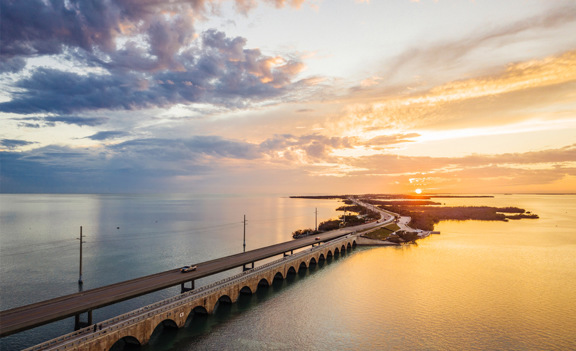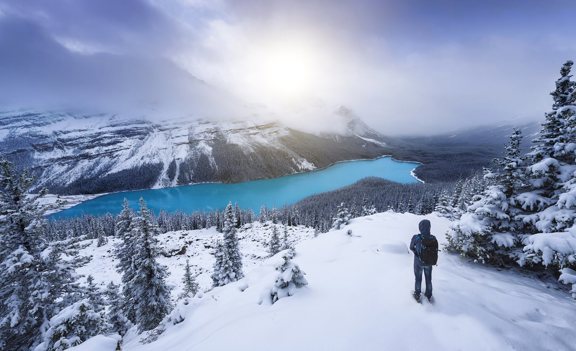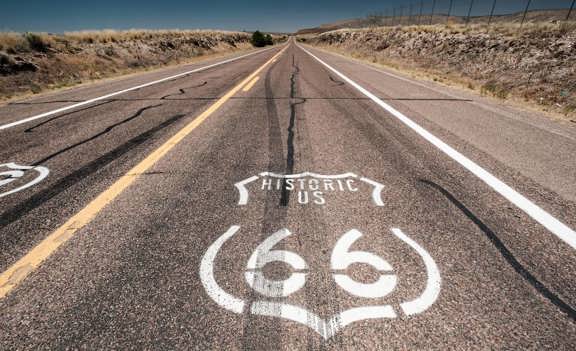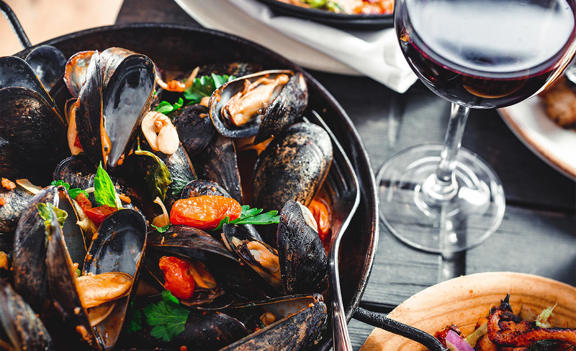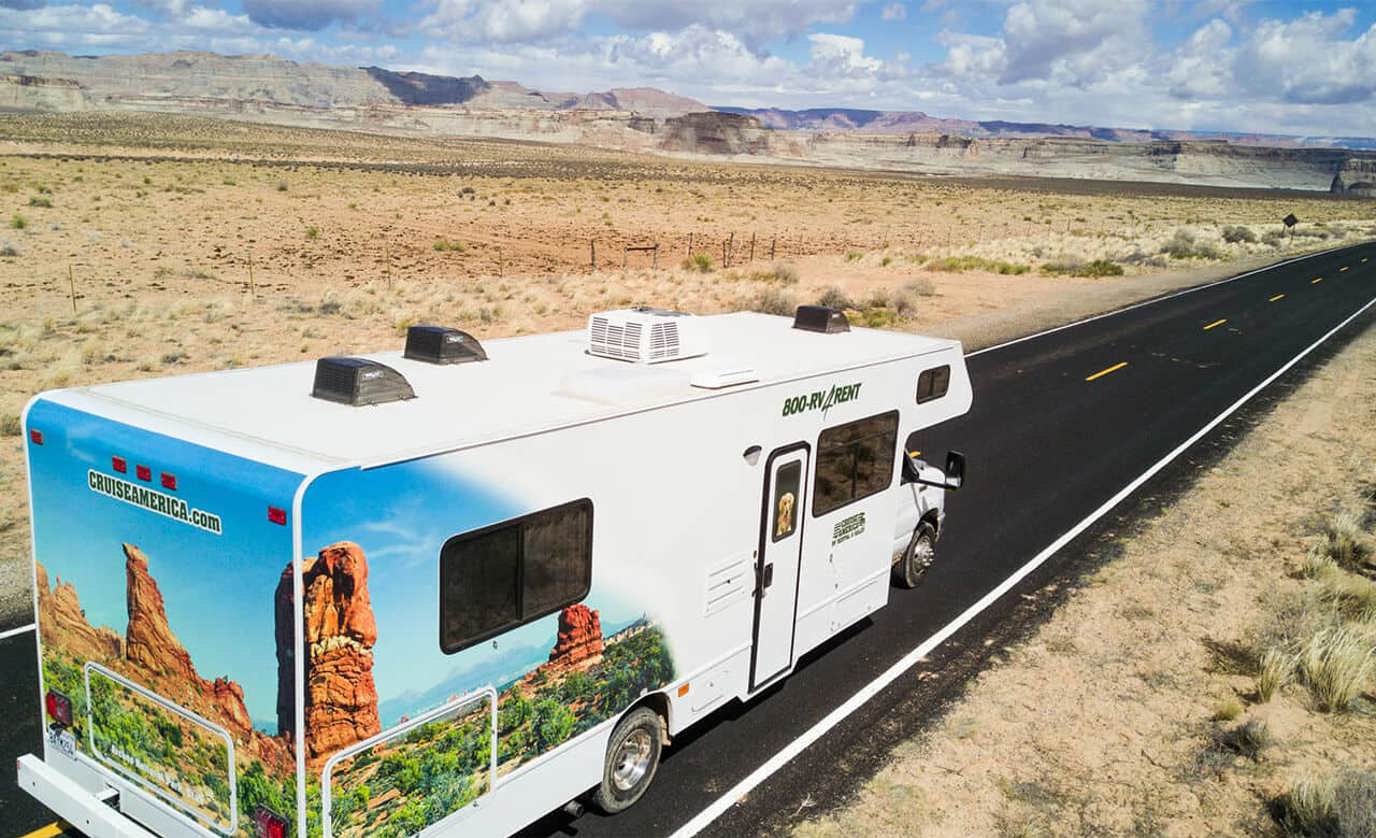

The Mother Road has carried travelers through eight states and countless small towns, but for many, the heart of the adventure begins with Route 66 in Arizona and Route 66 in California. This stretch of the historic route offers some of the most iconic stops on the entire road trip, from ghost towns tucked into desert hills to neon diners and quirky roadside attractions that feel pulled straight from the past.
Crossing the Arizona state line, you’ll find yourself surrounded by dramatic landscapes, with the Colorado River carving a natural border and desert highways leading you west toward California. As you drive through these towns, you’ll see why this part of the historic Route 66 is so often celebrated—it’s a living museum of America’s car culture, family vacations, and the glory days of the old road before the Interstate Highway System.
On the California border, the journey takes on a new character. Here the Mother Road Route winds through desert outposts, ghost towns, and eventually the bustling streets of Los Angeles, ending at the Santa Monica Pier—the symbolic western terminus of Route 66.
In this last section of our Route 66 series, we’ll guide you through Arizona and California’s highlights, from Oatman’s burros to Barstow’s museums and finally the historic places of downtown Los Angeles. Whether you’re retracing the early years of the highway or planning a new RV trip, this stretch of Route 66 proves why it’s still known as America’s Main Street.
Route 66 Arizona Mileage & Towns
Route 66 in Arizona covers about 401 miles, passing through classic small towns, ghost towns, and vibrant communities that keep the Mother Road spirit alive. Here’s what you can expect as you cross from the New Mexico border to the California border:
-
Lupton – Just over the state line, Lupton greets you with classic trading posts and roadside shops that recall the early years of Route 66. It’s a great place to pick up Native American crafts and souvenirs before heading further west.
-
Holbrook – Famous for the Wigwam Motel and nearby Petrified Forest National Park, Holbrook is a must-see stop where the old road still feels alive. You’ll also find murals, vintage diners, and classic cars lining the streets.
-
Joseph City – Known for its quirky Jack Rabbit Trading Post with the “Here It Is” billboard, Joseph City offers one of Route 66’s most iconic quirky roadside attractions. It’s a photo op every traveler should make time for.
-
Winslow – Thanks to the Eagles’ song, Winslow is home to the “Standin’ on the Corner” park, celebrating Route 66 in pop culture. With vintage cafés and historic places, it’s a perfect stretch-your-legs stop on your road trip.
-
Flagstaff – Set against the San Francisco Peaks, Downtown Flagstaff blends Route 66 history with a lively modern atmosphere. With breweries, historic places, and access to the Grand Canyon, it’s one of Arizona’s most popular towns on the route.
-
Williams – The last town on Route 66 to be bypassed by the Interstate, Williams proudly preserves its historic Route 66 character. It’s also the gateway to the Grand Canyon Railway, a classic way to visit the park.
-
Ash Fork – Known as the “Flagstone Capital of the World,” Ash Fork is dotted with vintage motels and relics from Route 66’s early years. It’s a quieter stop but a true piece of the Mother Road Route.
-
Seligman – Often credited with kicking off Route 66’s revival, Seligman is home to retro diners, neon lights, and memorabilia shops. It’s a living museum of the historic route, and the birthplace of the Historic Route 66 Association.
-
Peach Springs – Located on the Hualapai Reservation, Peach Springs connects travelers to the Hualapai Hilltop and Grand Canyon West. It’s a culturally rich stop that adds depth beyond the typical tourist trail.
-
Kingman – With its Route 66 museums, murals, and easy access to desert scenery, Kingman is often called the “Heart of Route 66 in Arizona.” It’s also a practical RV stop with campgrounds and services.
-
Oatman – This former mining ghost town is famous for its wild burros wandering the streets of Downtown Oatman. Wooden sidewalks, staged gunfights, and rustic storefronts make it feel like a step back into the early years of the American West.
-
Topock / Golden Shores – Just before the California border, these riverfront towns give you one last taste of Arizona hospitality. It’s a relaxing stop along the Colorado River, where you can enjoy the desert views before pressing on to California.
Oatman and Kingman: A Living Slice of the Mother Road

Few places capture the spirit of the Mother Road like Oatman and Kingman. Both towns showcase the personality, grit, and charm that made Route 66 in Arizona legendary, each offering a distinct experience for travelers driving the historic route.
Oatman: The Ghost Town That Refuses to Fade
Perched along the winding Oatman Highway and through Sitgreaves Pass, Oatman is a former mining ghost town that’s come back to life thanks to Route 66 tourism. Wooden sidewalks, staged gunfights, and shops selling souvenirs make it feel like stepping into the early years of the American West. The biggest attraction, though, is the herd of wild burros that roam freely through Downtown Oatman, greeting visitors as if they’ve always belonged here.
Kingman: The Heart of Route 66 in Arizona
Just west of Oatman, Kingman blends history and convenience for modern-day travelers. Known as the “Heart of Route 66 in Arizona,” it features the Historic Route 66 Museum, murals, and plenty of places to stop for food or rest. Kingman also preserves pieces of the old route and the bridges that carried travelers before the Interstate Highway System shifted traffic elsewhere.
For RVers, Kingman is a practical stop as well. With campgrounds, RV services, and access to nearby attractions, it’s an ideal base for exploring the Mother Road Route. Between Oatman’s quirky frontier vibe and Kingman’s blend of nostalgia and modern comfort, this stretch of the historic Route 66 is a must on any Route 66 road trip through Arizona.
Seligman and Ash Fork: Main Street of America Preserved

Traveling through Seligman and Ash Fork feels like stepping into the golden era of Route 66 in Arizona, where the Mother Road once pulsed with cross-country travelers and roadside businesses. Both towns have worked hard to keep their historic places alive, giving visitors a true sense of Route 66’s early years.
Seligman: Birthplace of the Historic Route 66 Association
Seligman is often called the birthplace of the Historic Route 66 Association, founded in the 1980s to help revive interest in the old road after much of the traffic shifted to the Interstate. Today, the town thrives on nostalgia, with neon-lit diners, vintage motels, and shops filled with classic cars, memorabilia, and quirky displays. This is Main Street America at its finest, where nearly every storefront is dedicated to preserving the spirit of the historic route 66.
Ash Fork: A Quiet Slice of the Past
Just west of Seligman, Ash Fork may be smaller and quieter, but it holds a unique claim to fame as the “Flagstone Capital of the World.” Scattered motels and diners stand as reminders of when the original route carried families through this desert town. Though bypassed by the Interstate Highway System, it still offers a glimpse into the grit of Route 66’s early years, complete with faded signage and fragments of the old road that remain paved today.
Together, Seligman and Ash Fork preserve the essence of the Mother Road Route. Whether you’re stopping for a meal, snapping photos of roadside murals, or walking along Main Street, these stops embody why Route 66 is still celebrated as “America’s Main Street.”
Hackberry to Joseph City: Echoes of the Early Years

The drive between Hackberry and Joseph City offers some of the best preserved glimpses into the early years of Route 66 in Arizona. Along this stretch of the historic route, you’ll encounter roadside icons that feel frozen in time, where the old road still carries the echoes of travelers from decades past.
Hackberry General Store: A Quirky Roadside Attraction
The Hackberry General Store is a true quirky roadside attraction, drawing road trip adventurers from around the world. Covered in vintage signs, classic cars, and Route 66 memorabilia, it’s part museum, part gift shop, and 100% Mother Road charm. RV travelers can easily pull over to explore this slice of nostalgia, making it one of the most photographed stops along the historic Route 66.
Joseph City: The Famous Jack Rabbit Trading Post
Continuing west, you’ll reach Joseph City, home to one of Route 66’s most enduring symbols: the Jack Rabbit Trading Post. Its giant “Here It Is” billboard has become a rite of passage for travelers since the early years of the highway. This humble convenience store and trading post stand as a reminder of when the original route was a vital link for families heading across America.
Together, Hackberry and Joseph City highlight how small towns along Route 66 managed to survive by embracing their history. Whether it’s the playful vibe of Hackberry or the cultural significance of Joseph City, this part of the Mother Road Route showcases why the highway is still celebrated today.
Williams and Flagstaff: Champions of Historic Route 66

The towns of Williams and Downtown Flagstaff have become central to preserving the identity of Route 66 in Arizona. Both destinations celebrate the Mother Road Route not only as a piece of nostalgia but also as a living, breathing part of their communities today.
Williams: The Last Town Bypassed by the Interstate
Known as the last town on Route 66 to be bypassed by the Interstate Highway System, Williams has embraced its heritage as a guardian of the historic route 66. Neon-lit motels, retro diners, and souvenir shops line the streets, giving travelers a sense of what the old road looked like in its heyday. It’s also home to the Grand Canyon Railway, which provides a vintage way to reach one of America’s greatest historic places—the Grand Canyon.
Flagstaff: Historic Route 66 Association Pride
Just east of Williams, Flagstaff has long been a hub of Route 66 culture. Murals, restored bridges, and old motels preserve the atmosphere of the early years, while modern breweries and restaurants keep the downtown vibrant. It’s here that the Historic Route 66 Association has had a strong influence in keeping Route 66 alive, ensuring that future generations can connect with its history.
For RVers, Flagstaff is especially appealing as a base for exploring Northern Arizona. From here, you can take side trips to the Painted Desert, the Petrified Forest, or the Grand Canyon itself. Combined with Williams’ classic Main Street charm, these two towns remain must-see stops for anyone tracing the Mother Road across Arizona.
Crossing the California Border: Route 66 Through the Desert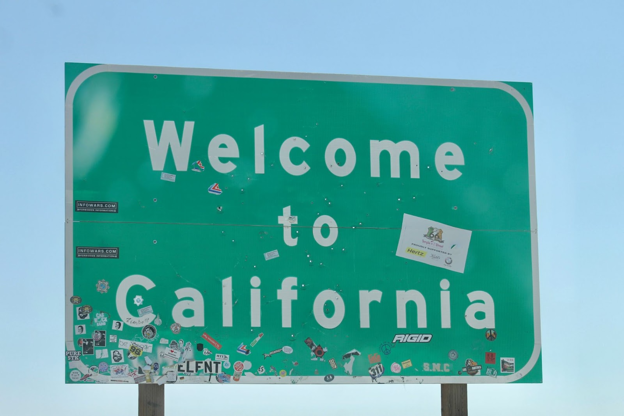
Leaving Arizona at Topock and Golden Shores, Route 66 crosses the California border and plunges into the vast Mojave Desert. This stretch of the Mother Road is legendary for its isolation—miles of open desert, long-forgotten ghost towns, and abandoned gas stations that once served travelers on the old route. For many RVers, this is where the journey turns into a true test of endurance, echoing the experiences of families who crossed here during the early years of the highway.
Route 66 in California: Mileage & Towns
Route 66 in California runs for about 315 miles, beginning at the Arizona line near Needles and ending at the Santa Monica Pier in Los Angeles, the symbolic western terminus of the highway. Along the way, it passes through desert outposts, historic towns, and bustling cities that define the final leg of the Mother Road Route.
Major towns and cities along California’s stretch of Route 66 include:
-
Needles (first stop after crossing from Arizona)
-
Goffs
-
Essex
-
Amboy
-
Ludlow
-
Newberry Springs
-
Barstow
-
Oro Grande (home of the Bottle Tree Ranch)
-
Victorville
-
San Bernardino
-
Pasadena
-
Downtown Los Angeles
-
Santa Monica (the official end of the road)
Needles: First Stop in California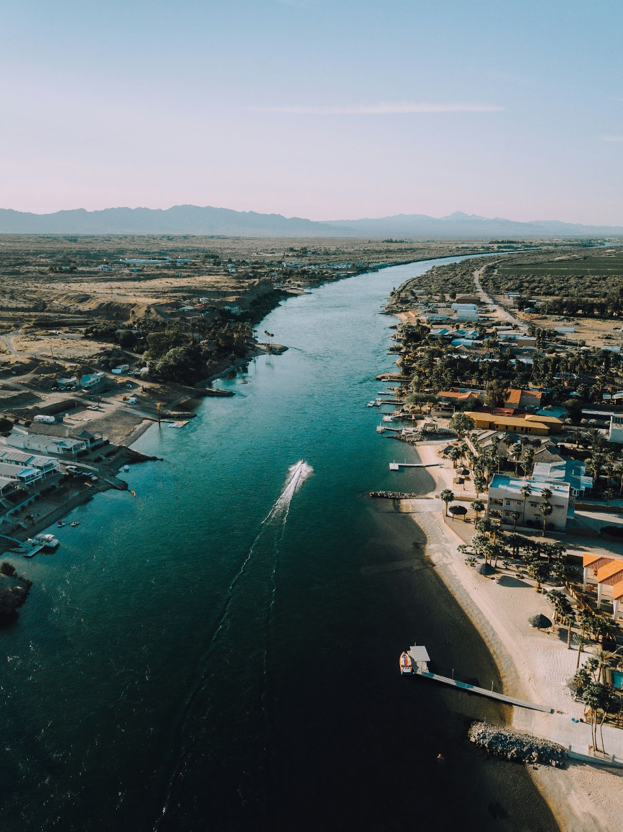
Just west of the Arizona state line, the town of Needles is the first major stop on Route 66 in California. Once a thriving railroad hub, it later became a vital stop for travelers on the historic route 66, offering motels, diners, and fuel before the long trek across the Mojave. Today, RVers will still find campgrounds and services here, making it a smart place to rest and refuel.
Desert Highways and Classic Americana
From Needles, the road trip west unfolds across stark desert scenery. Vintage neon signs, weathered motels, and remnants of the original route are scattered along the way, each telling a story of migration, survival, and the American dream. These desert highways reflect both the grit and romance of the Mother Road Route, still drawing travelers from around the world to see this piece of America’s history.
Crossing into California sets the stage for some of the most iconic sights on the entire historic route. From Amboy’s Roy’s Motel and Café to the Bottle Tree Ranch, this desert corridor is proof that even the quietest stretches of Route 66 can be packed with character and historic places worth exploring.
From Amboy to Barstow: Landmarks Along the Historic Route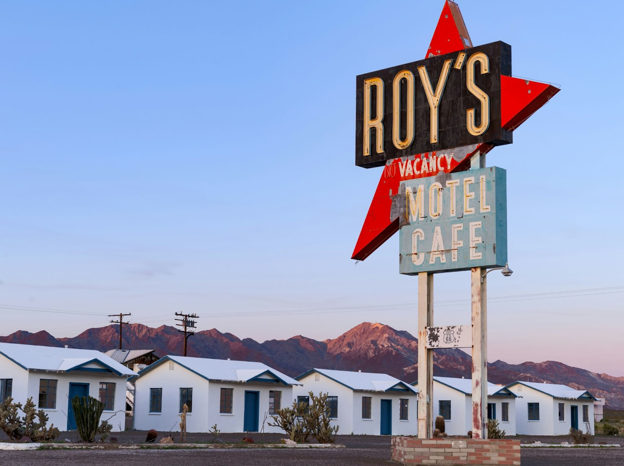
The desert between Amboy and Barstow is one of the most iconic stretches of Route 66 in California, where the highway’s early years still echo through faded neon and weathered buildings. Driving this part of the historic route, you’ll pass through stark desert landscapes, quirky Americana, and long stretches of open highway that feel worlds away from the bustle of Los Angeles.
Amboy & Roy’s Motel and Café
A true quirky roadside attraction, Amboy is home to the famous Roy’s Motel and Café. Once a bustling stop for travelers on the old road, today it’s a symbol of Route 66’s past. With its Googie-style sign and retro gas pumps, it’s a favorite photo stop for RVers heading west across the Mojave.
Bottle Tree Ranch – Oro Grande
Just north of Victorville sits the Bottle Tree Ranch, a surreal forest of welded pipes decorated with hundreds of colorful glass bottles. This popular attraction captures the creativity and resilience of the desert and is a highlight of the Mother Road Route. Like many sites on historic route 66, it blends nostalgia with art, reminding visitors how this old route inspired countless dreamers.
Barstow – A Hub of Route 66 History
Barstow has long been a hub for travelers, from the days of the National Old Trails Highway to the modern Interstate era. Today, it remains a key stop along Route 66 in California, with must-see sites like the Route 66 Mother Road Museum, the Western America Railroad Museum, and colorful murals that tell the story of America’s history on the road. For RVers, Barstow is also a practical overnight stop, with services and campgrounds conveniently located near the highway.
Together, Amboy, Oro Grande, and Barstow show how the desert keeps the Mother Road alive—offering everything from ghost towns and retro signs to thriving communities that continue to celebrate the legend of historic route 66.
Victorville to Los Angeles: Route 66’s Final Stretch
The last leg of Route 66 in California carries travelers from Victorville through the Inland Empire and into Downtown Los Angeles, before ending at the iconic Santa Monica Pier. This stretch of the historic route blends desert heritage, suburban sprawl, and big-city energy, making it a fitting finale for the Mother Road Route.
Victorville & San Bernardino
Victorville’s California Route 66 Museum is a must-see, filled with vintage memorabilia, murals, and exhibits that showcase the history of the old road. Heading south, San Bernardino stands as one of the most important towns along this part of the historic route 66, home to the site of the very first McDonald’s. Both cities keep the tradition of Route 66 alive, making them essential stops for those tracing the original route.
Pasadena & the Final Miles into Los Angeles
Driving further west, the road trip takes you past Pasadena, where you’ll find stretches of historic places and vintage architecture that recall the early years of the highway. Soon after, the route winds into Downtown Los Angeles, where neon signs, vintage motels, and roadside landmarks remind travelers that this is still America’s Main Street.
Santa Monica: The Western Terminus
At last, Route 66 reaches its symbolic end at the Santa Monica Pier. Marked by the famous “End of the Trail” sign, this western terminus is both a celebration and a farewell. Overlooking the Pacific Ocean, it’s the perfect place to reflect on the miles behind you—from the Arizona state line to the California coast—and the countless stories written along this legendary highway.
For RVers, finishing in Santa Monica feels like closing a chapter of America’s history. The route may no longer be the nation’s primary corridor, but its legacy as the Mother Road lives on in every diner, museum, and neon sign you’ve passed along the way.
Beyond the Mexico Border: Route 66’s Legacy
While Route 66 never officially crossed into Mexico, its history and influence have long extended beyond the Mexico border. Travelers from all over the world—especially from Latin America—have driven the Mother Road Route to experience its historic places, vintage diners, and the stories etched into the old road. The proximity of southern California to Mexico made Route 66 a natural gateway, symbolizing opportunity and connection for countless families.
Even though the highway was decommissioned in the 1980s, the legacy of the historic route 66 lives on. From ghost towns in the desert to the bustling streets of Los Angeles, Route 66 continues to draw dreamers chasing nostalgia and adventure. For RVers, this final stretch of the road trip isn’t just about reaching the Pacific—it’s about understanding how the Mother Road shaped travel, culture, and community across America.
The intersection of memory and modern travel is why Route 66 remains a pilgrimage. Whether you start at the New Mexico border, cross the Arizona state line, or finish in Santa Monica, the road still represents a spirit of exploration and resilience that transcends borders. It’s more than a highway—it’s a reminder of where we’ve been and how far the road can still take us.
RV Travel Tips for Arizona & California
Driving Route 66 in Arizona and Route 66 in California offers some of the most rewarding miles on the Mother Road, but desert conditions and long stretches of open highway require preparation. Here are some essential tips to make your RV road trip safe, comfortable, and memorable.
Plan for the Desert Climate
Both states feature arid landscapes, where summer temperatures can soar well above 100°F. Heat-related illnesses like exhaustion and stroke are real risks if you’re not prepared. Always travel with extra water, wear sun protection, and schedule longer drives for the early morning or evening hours when the traffic is lighter and the desert air is cooler.
Prep Your RV for Long Stretches
Gas stations can be few and far between in the Mojave and northern Arizona, so keep your tank topped off whenever possible. Double check your fluid levels, brakes, and tire pressure before hitting long isolated stretches. Carry an emergency kit with jumper cables, flashlights, and a basic tool set—small items that can save you big headaches on the old road.
Stay in RV-Friendly Stops
Many of the towns along Route 66 welcome RV travelers, with campgrounds in places like Kingman, Flagstaff, Barstow, and Needles. These stops let you enjoy iconic attractions while having a safe, comfortable place to park overnight. Sticking close to historic places like museums and diners also deepens your connection to the history of the highway.
Navigate the Original Route
While much of Route 66 has been replaced by the Interstate, portions of the original route are still drivable. These fully paved sections take you through ghost towns, past bridges, and into small towns that showcase the authentic character of the Mother Road Route. Download maps or apps dedicated to Route 66 to help you follow the historic route 66 instead of accidentally bypassing it on newer roads.
By planning carefully and embracing the quirks of the Mother Road, RV travelers can enjoy every mile of this legendary trip—from the New Mexico border to the Pacific coast.
Experience Route 66 Arizona & California with Cruise America
From the desert hills of Oatman to the neon-lit streets of Downtown Los Angeles, the stretch of Route 66 in Arizona and Route 66 in California captures everything travelers love about the Mother Road. Along these 700+ miles, you’ll pass through ghost towns, historic diners, quirky trading posts, and thriving small towns that keep the history of the old road alive. And at the Santa Monica Pier—the symbolic western terminus—you’ll find the perfect place to celebrate the end of your road trip across America.
Ready to make the legendary Route 66 your next adventure? Rent an RV with Cruise America and set out to explore the Mother Road Route through Arizona and California, creating memories that will last long after the journey ends.
